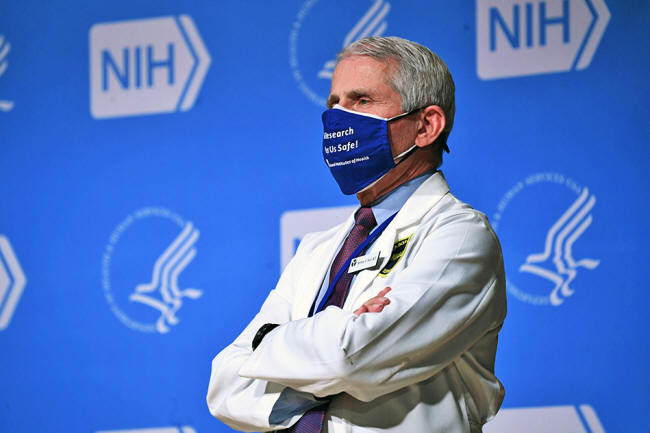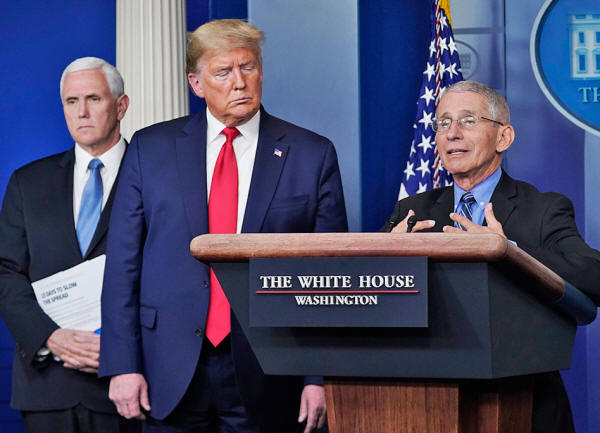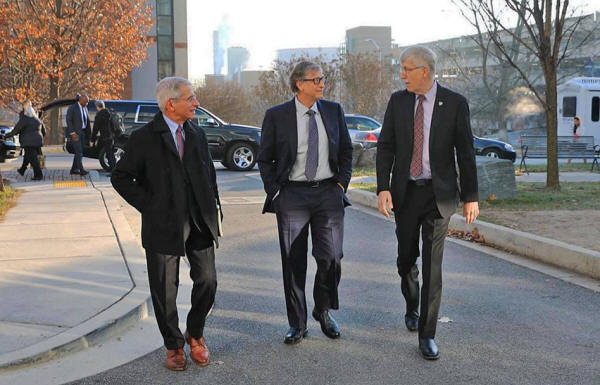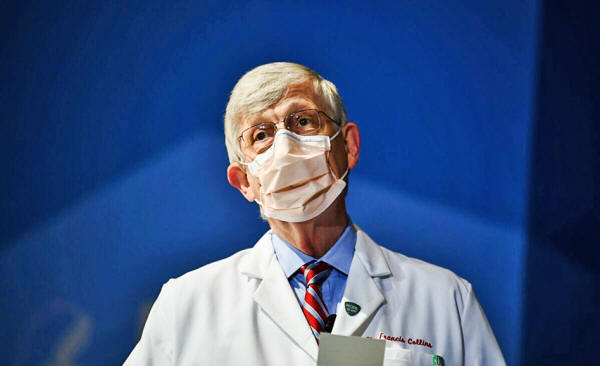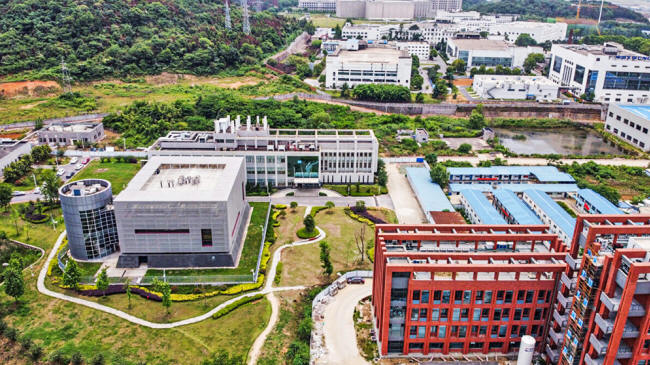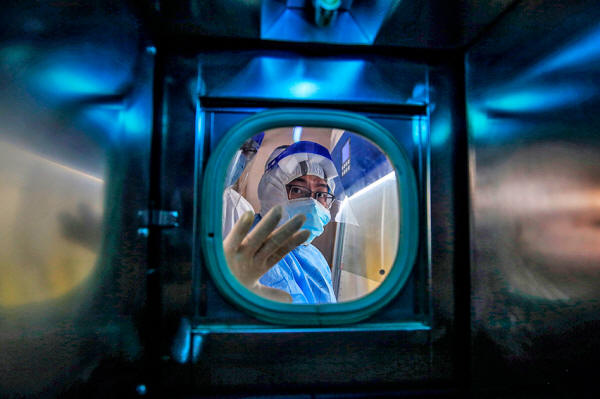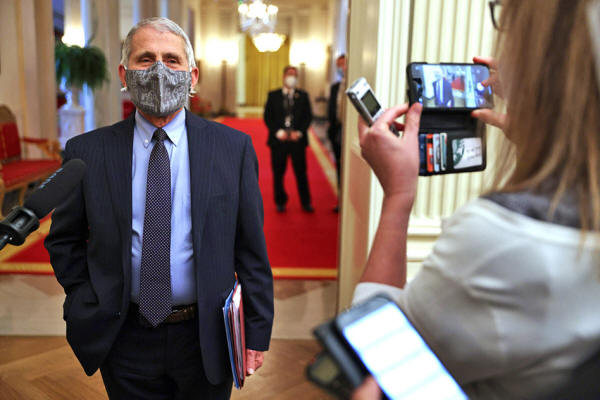|
Updated: January 27, 2022
from
TheEpochTimes Website
White House Chief Medical Adviser on Covid-19 Dr. Anthony Fauci at the National Institutes of Health (NIH) in Bethesda, Maryland, on Feb. 11, 2021. (SAUL LOEB/AFP via Getty Images)
Fauci's involvement with the paper wasn't acknowledged by the authors as it should have been under prevailing academic standards.
Neither was it acknowledged by Fauci himself, who denied having communicated with the authors when asked directly while testifying before Congress earlier this month.
The article "The Proximal Origin of SARS-CoV-2" was co-authored by five virologists, four of whom participated in a Feb. 1, 2020, teleconference that was hastily convened by,
...after public reporting of a potential link between the Wuhan Institute of Virology in China and the COVID-19 outbreak.
The initial draft of "Proximal Origin" was completed on the same day the teleconference, which wasn't made public, took place.
Notably, at least three authors of the paper were privately telling Fauci's teleconference group both during the call and in subsequent emails that they were 60 to 80 percent sure that COVID-19 had come out of a lab.
Until now, it wasn't known what role, if any, Fauci played in shaping the contents of the paper, which formed the primary basis for government officials and media organizations to claim the "natural origin" theory for the virus.
While the contents of emails previously released under the Freedom of Information Act (FOIA) show the paper clearly conflicts with the authors' private views on the virus's origin, it was unclear whether the authors had preemptively reshaped their views to please Fauci, or whether Fauci himself had an active role in shaping the article.
As the head of NIAID, Fauci controls a large portion of the world's research funds for virologists.
At least three virologists involved in the drafting of "Proximal Origin" have seen substantial increases in funding from the agency since the paper was first published.
Any interference by Fauci in the paper's narrative would present a serious conflict of interest.
Emails show that Fauci, Collins exerted Influence
Newly released notes taken by House Republican staffers from emails that still remain largely redacted clearly point to Fauci having been actively engaged in shaping the article and its conclusion.
The GOP lawmakers gained limited access to the emails after a months-long battle with Fauci's parent body, the Department of Health and Human Services.
The new emails reveal that on Feb. 4, 2020, one of the article's co-authors, virologist Edward Holmes, shared a draft of "Proximal Origin" with Farrar.
Like Fauci, Farrar controls the disbursement of vast amounts of funding for virology research.
Holmes prefaced his email to Farrar with the note that the authors,
It isn't known what other anomalies Holmes was referring to, but his statement indicates that the paper's authors may have omitted,
Dr. Anthony Fauci (R), director of the National Institute of Allergy and Infectious Diseases, speaks while U.S. President Donald Trump (C) and Vice President Mike Pence listen during a briefing on the coronavirus pandemic, in the press briefing room of the White House on March 24, 2020. (Drew Angerer/Getty Images)
During Fauci's teleconference, participants had discussed at least two anomalies specific to the virus:
Farrar almost immediately shared Holmes's draft with Fauci and Collins via email, while excluding other participants of the teleconference.
The ensuing email thread containing discussion among the three suggests that the reason for the secretiveness may have been that they were shaping the content of the paper itself, something that has never been publicly acknowledged.
It's notable that the email thread included only the three senior members of the teleconference. Using Farrar as a conduit to communicate with the authors may have been seen by Fauci and Collins as adding a layer of deniability.
Antony Fauci, Bill Gates and Francis Collins...
Fauci, Collins express Concern Over 'Serial Passage'
During a Feb. 4, 2020, email exchange among the men, Collins pointed out that the paper argued against an engineered virus, but that serial passage was "still an option" in the draft.
Fauci appeared to share Collins's concerns, noting in a one-line response:
Serial passage is a process whereby a virus is manipulated in a lab by repeatedly passing it through human-like tissue such as genetically modified mice, which mimic human lung tissue.
This is notable given that during the Feb. 1 teleconference, at least three of the paper's authors had advised Collins and Fauci that the virus may have been manipulated in a lab through serial passage or by genetic insertion of certain features.
Then-National Institutes of Health Director Dr. Francis Collins stands in Bethesda, Md., on Jan. 26, 2021. Collins stepped down in December 2021. (Brendan Smialowski/AFP via Getty Images)
One day after Fauci and Collins shared their comments, on Feb. 5, 2020, Farrar emailed Fauci and Collins stating:
The reference to glycans is notable as they are,
The push by Fauci, Collins, and Farrar to have the paper's authors expand on the issue of glycans appears to confirm that they were exerting direct influence on the paper's content.
According to Rossana Segreto, a microbiologist and member of the virus origins search group DRASTIC, emphasizing the presence of glycans in SARS-CoV-2 might suggest that Fauci and his group were looking to add arguments against serial passage in the lab.
A study later found that the paper's prediction on the presence of the O-linked glycans wasn't valid.
The newly released emails don't reveal what additional discussions may have taken place among Fauci, Collins, and Farrar in the ensuing days.
Perhaps that's partly because Farrar had noted on another email thread addressed to Fauci's teleconference group that scientific discussions should be taken offline...
Online Version appears to Incorporate Fauci's, Collins's Suggestions
Eleven days later, on Feb. 16, 2020, "Proximal Origin" was published online.
An immediate observation from an examination of the Feb. 16 version of the paper is that "glycans," the term that Farrar, Fauci, and Collins wanted to emphasize, is cited 12 times.
We don't know to what extent glycans were discussed in the Feb. 4 draft, as it remains concealed by National Institute of Health (NIH) officials.
An item of particular significance is that the Feb. 16 version omits any mention of the ACE2-transgenic mice that Fauci had initially flagged in his Feb. 4 email to Collins and Farrar.
While the Feb. 16 version of the paper acknowledges that a furin cleavage site could have been generated through serial passage using animals with ACE2 receptors, the cited animals in the Feb. 16 version were ferrets - not transgenic mice...
The P4 laboratory on the campus of the Wuhan Institute of Virology in Wuhan, Hubei Province, China, on May 13, 2020.
(Hector Retamal/AFP via Getty Images) The authors' use of ferrets is peculiar not only because the term "transgenic mice" was almost certainly used in the Feb. 4 version, but also because it was known at the time that the Wuhan Institute of Virology was conducting serial passage experiments on coronaviruses using ACE2 transgenic mice.
Even more conspicuously, the reference to ferrets was removed entirely from a March 17 updated version of the paper.
In its place, a passage was added that stated,
...despite the fact that the Wuhan Institute's work with ACE2 transgenic mice has been extensively described in academic papers.
Published Version of 'Proximal Origin' Was Altered
Following the online publication of "Proximal Origin" on Feb. 16, 2020, the article was published in the prominent science journal Nature on March 17.
In addition to the changes surrounding the transgenic mice, a number of other notable edits were made to strengthen the natural origin narrative.
On March 6, 2020, the paper's lead author, Kristian Andersen, appeared to acknowledge the inputs from Collins, Farrar, and Fauci, when he emailed the three to say,
Perhaps most strikingly, the most often publicly cited passage from the March 17 version of the paper - which states,
...doesn't appear in the Feb. 16 version.
Additionally, while the Feb. 16 version states that,
Similar changes in language are evident in various parts of the March 17 version.
For example, a section that stated that,
A medical staff member gestures inside an isolation ward at Red Cross Hospital in Wuhan in China's Hubei Province on March 10, 2020.
(STR/AFP
via Getty Images) The March 17 version also omits an entire section from the Feb. 16 version that centered around an amino acid called phenylalanine.
According to Segreto, a similarly situated amino acid in the original SARS virus had,
Segreto surmises that the "Proximal Origin" authors might have deleted this section so as not to highlight that the phenylalanine in SARS-CoV-2 might have resulted from serial passage in a lab.
Segreto's analysis is backed up by the fact that another section in the Feb. 16 version - which states that "experiments with [the original] SARS-CoV have shown that engineering such a site at the S1/S2 junction enhances cell-cell fusion" - was reworded in the March 17 version to leave out the word "engineering."
Indeed, while the Feb. 16 version merely downplayed the possibility of the virus having been engineered in a lab, in the March 17 version, the word "engineered" was expunged from the paper altogether.
Another sentence omitted from the March 17 version noted that,
Had the sentence remained, it would have suggested that, unlike other regions in China, no SARS-related viruses were circulating in Wuhan in the years leading up to the pandemic.
That makes natural spillover less likely.
The director of the Wuhan Institute of Virology, Shi Zhengli, herself admitted that she never expected a SARS-related virus to emerge in Wuhan.
When viruses emerged naturally in the past, they emerged in southern China.
Shi's credibility already was coming under fire for failing to disclose that she had the closest known relative of SARS-CoV-2 in her possession for seven years - a point noted early on by Segreto.
Additionally, the Wuhan Institute took its entire database of viral sequences offline on Sept. 12, 2019.
Despite the Wuhan Institute's documented deletion and concealment of data, "Proximal Origin" 's central argument is that SARS-CoV-2 had to be natural since its backbone didn't match any known backbones.
However, even before the March 17 version was published, Segreto had stated publicly that the paper's central backbone argument was inherently flawed, precisely because there was no way of knowing whether the Chinese lab had published the relevant viral sequences.
Fauci, Collins, Farrar Roles improperly Concealed
The email exchange among Fauci, Farrar, and Collins presents clear evidence that the three men took an active role in shaping the narrative of the paper.
Indeed, a careful comparison of the Feb. 16 and March 17 versions shows that the changes made fail to reflect any fundamental change in scientific analysis.
Instead, the authors employed linguistic changes and wholesale deletions that appear to have been designed to reinforce the natural origin narrative.
Close scrutiny of the email discussions by the three scientists also suggests that there was no legal justification for redacting any of the newly released information in the first place.
Dr. Anthony Fauci, director of the National Institute of Allergy and Infectious Diseases, talks to members of the press prior to an event at the State Dining Room of the White House on Jan. 21, 2021. (Alex Wong/Getty Images)
Science journals require that contributions to scientific papers need to be acknowledged.
According to Nature's publishing guidelines,
The newly revealed sections of the still-redacted emails appear to confirm that Fauci, Farrar, and Collins met the criteria for acknowledgment, yet their names have never appeared on any published version of the paper, suggesting that the three didn't want their involvement in its creation to be known.
Collins asked Fauci 'to Help Put Down' Fox News Story
A final email released by the House Republicans shows that Collins wrote Fauci several months later on April 16, 2020, telling him that he had hoped that "Proximal Origin" would have "settled" the origin debate, but that it apparently hadn't, since Bret Baier of Fox News was reporting that sources were confident the virus had come out of a lab.
Collins asked Fauci whether the NIH could do something,
Collins also suggested that he and Fauci ask the National Academy of Sciences, Engineering, and Medicine (NASEM) to weigh in.
As was revealed in previous emails released under FOIA, Fauci's group had pushed NASEM in early February 2020 to promote the natural origin narrative.
Fauci told Collins that the lab leak theory was a "shiny object" that would go away in time.
However, the next day, Fauci took responsive action when he categorically dismissed the possibility of a lab origin of COVID-19 during on April 17, 2020, White House press conference.
Notably, Fauci feigned independence, telling reporters that he couldn't recall the names of the authors.
Unbeknownst to reporters and the public at the time, four out of the five authors had participated in Fauci's Feb. 1, 2020, teleconference. Now, we know that Fauci had involvement in shaping the very article that he cited.
Fauci's intervention at the April 17 White House briefing was effective, since media interest in the lab leak theory quickly waned.
It didn't resurface until May 2021, when former New York Times science writer Nicholas Wade published an article discussing the likelihood of a lab leak.
Wade noted that,
Notably, Segreto had raised a similar concern after "Proximal Origin" was first published in February 2020, asking whether certain virologists were scared that if the truth came out, their research activities would be curtailed...
|


